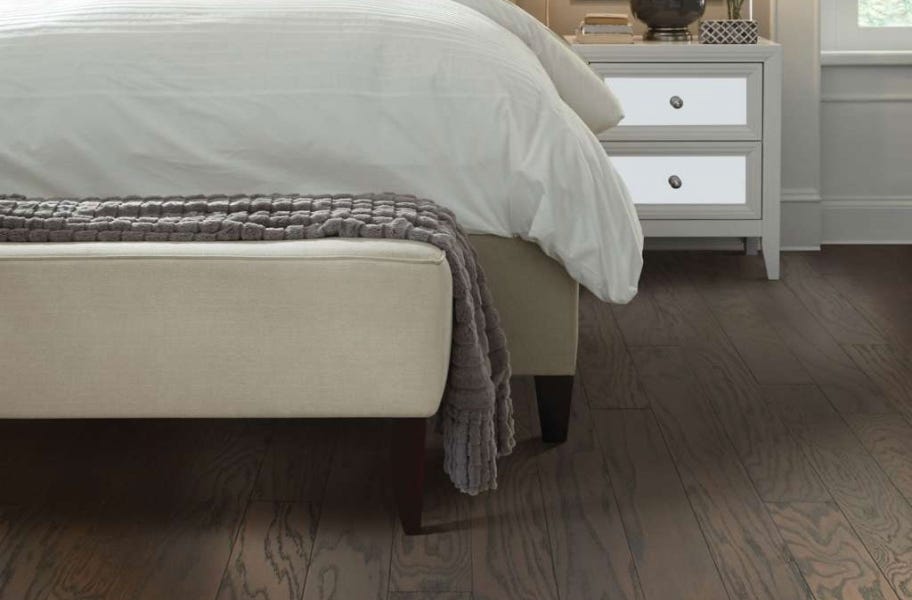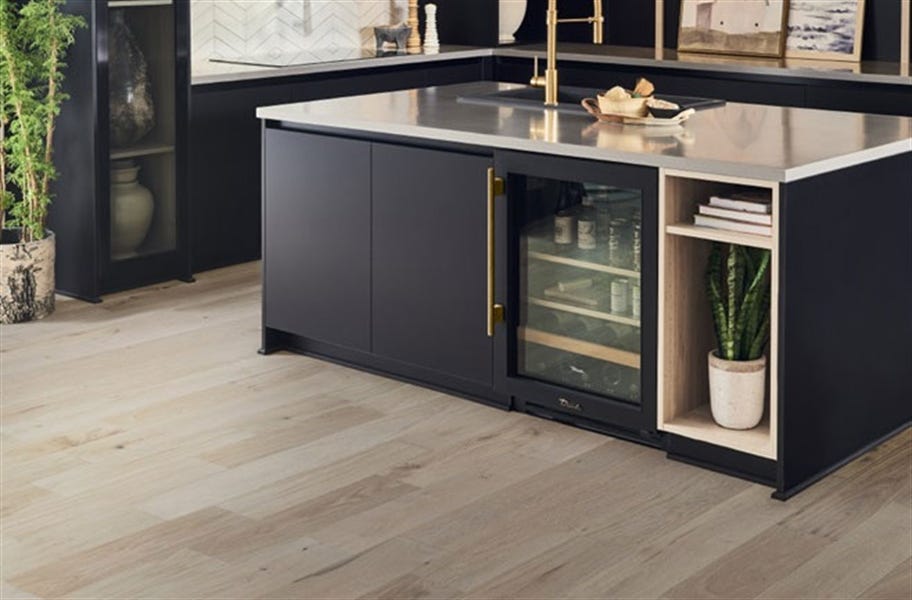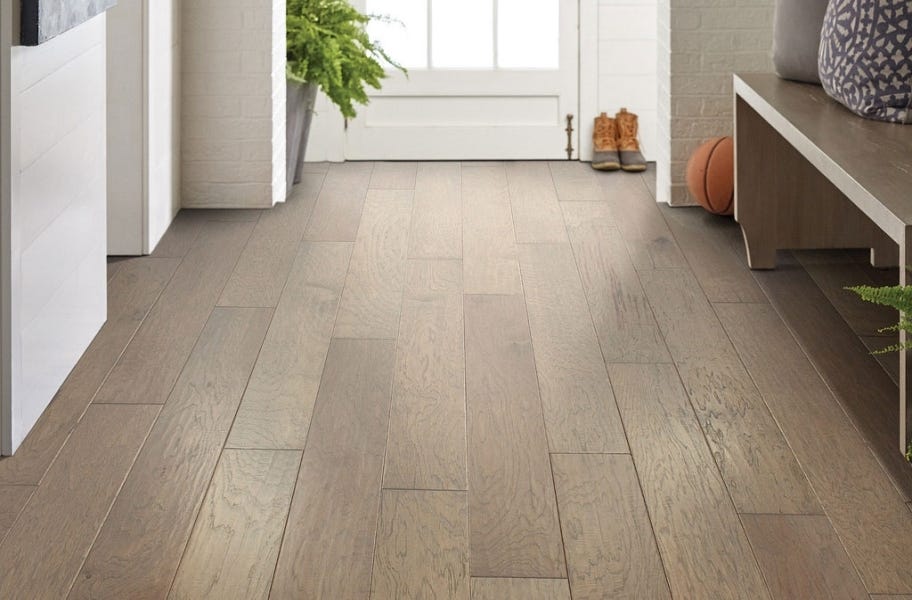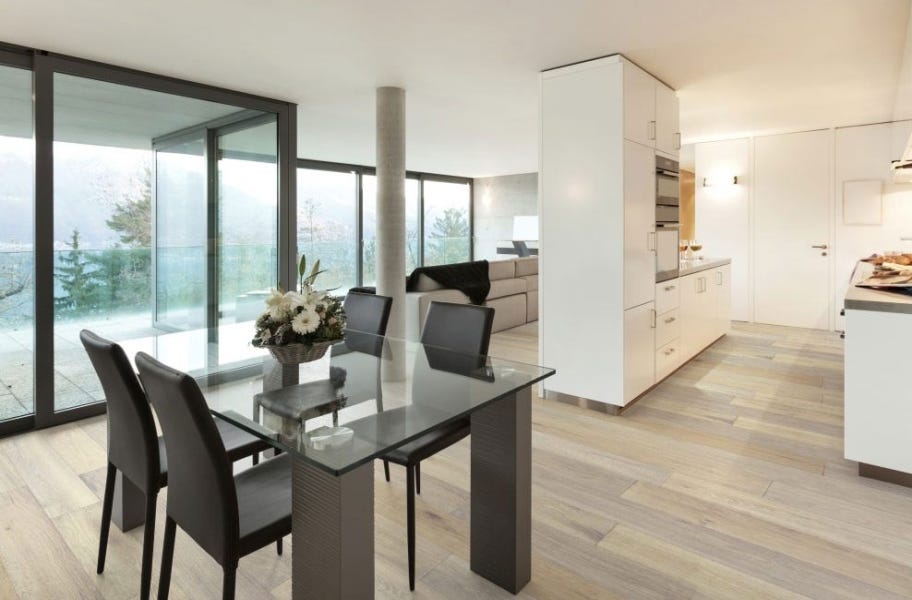
Engineered wood flooring is a durable alternative to solid hardwood flooring, featuring a real wood surface layer and an engineered core. With engineered hardwood floors, you get the warmth and beauty of genuine wood planks with the added benefit of durability and water-resistant flooring.
That’s right! It’s wood flooring 2.0.
Discover how engineered hardwood adds value to your home with the different styles available, plus the pros and cons, so you know exactly what to expect with your flooring.
Engineered Hardwood Flooring: The Basics
Part wood floor, part engineering masterpiece, engineered wood flooring offers the best of both worlds. The real wood veneer layer offers the style and unique look of naturally occurring planks.
Meanwhile, the engineered core delivers the durability you can’t find with genuine wood flooring. This core can be made of high-density fiberboard (HDF), stone-plastic composite (SPC), or engineered plywood.
The floor’s core also offers resiliency, durability, and some moisture resistance that solid hardwood doesn’t have.
I’m sure you’re excited to learn more about engineered hardwood. So let’s jump in!
| Related Content >> Engineered Hardwood vs. Laminate Flooring |
Layers of Engineered Wood Flooring
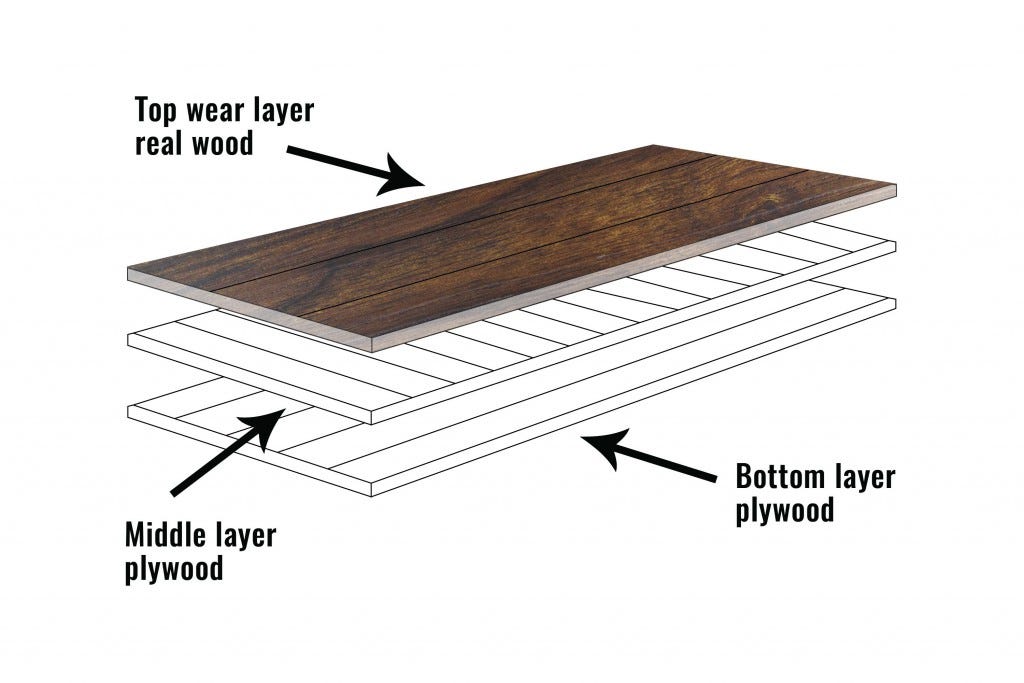
The moisture resistance of engineered hardwood comes from the layered design. This flooring will be more or less resistant to moisture depending on the composition of those layers.
Veneer Layer
Here’s where you find the veneer of genuine wood that gives your flooring its beautiful, unique look. While some engineered wood planks are made more durable by a scratch-resistant finish, the veneer layer hangs tough against wear and tear. Plus, the wood veneer can be almost any wood species you want.
The manufacturer will determine in their instructions if this layer is thick enough to refinish or not. Always check the manufacturer’s instructions before sanding or refinishing engineered wood.
Core Layer
This is the powerhouse of the plank. The core increases the durability of your floor and is often specifically designed to reduce expansion and contraction with changes in ambient temperatures.
Engineered hardwood’s high-density fiberboard (HDF), stone-plastic composite (SPC), or engineered plywood core offers moisture resistance, especially paired with wax and other water-repellent materials. The moisture resistance of an engineered core lessens the odds that your floors will buckle when installed properly.
Backing Layer
The backing on most engineered wood planks is another type of wood similar to the veneer on top of the plank. This layer provides a sturdy foundation for your floor and works perfectly with your choice of underlayment.
While some engineered hardwood comes with an attached underlayment, it’s more common to use a separate underlayment with a moisture barrier for added protection.
Where to Use Engineered Wood Flooring
Engineered wood floors are so versatile that they work well in every room and on every level of the home. They’re stylish, durable, moisture-resistant, and add monetary value to your home, so they have something to offer wherever you install them.
Here are a few places you’re going to love the option of engineered hardwood where traditional hardwood floors typically can’t be installed.
- Kitchens: Finally, you can have real wood in the kitchen. Engineered wood looks great and it holds up against moisture, so it’s going to thrive in a kitchen setting.
- Basements: Install engineered hardwood to benefit from a durable floor. It’s easy to take care of, too, so you won’t have a large area of high-maintenance flooring.
- Other high-traffic areas: With its thick surface layer and scratch-resistant finish, engineered hardwood is an excellent choice for many busy areas of the home.
Why Invest in Engineered Hardwood Flooring?
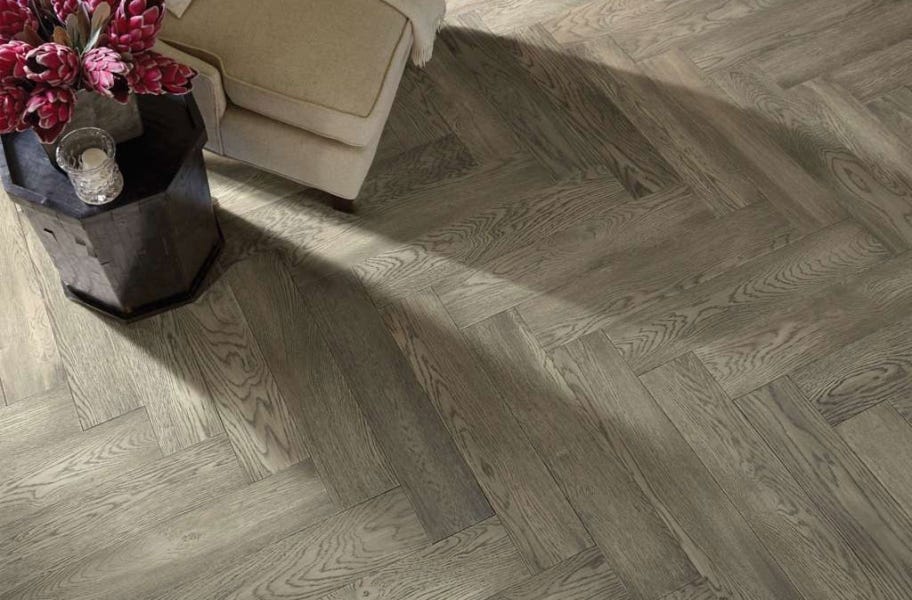
With so many flooring options out there, it can be hard to single out exactly what you want. Here are a few things to consider about engineered hardwood as you continue your search for the floor of your dreams.
And who knows? Maybe you’ve found your match.
- Increase your home resale value: Engineered hardwood is one of the few flooring choices that increase the resale value of your home. You’ll recoup 70% to 80% of your investment through your property values with engineered wood because of its style and durability. Not only does it cost less to install than solid hardwood, but also, with engineered wood, you get the realistic look of hardwood with more moisture resistance.
- Stylish: Wood flooring is classic. With engineered wood floors, you don’t have to settle for the look of wood. You get the real thing! Because it can be installed in areas that standard hardwood can’t, you can enjoy the timeless style of wood floors in more areas of the home.
- Every plank is unique: Since this is a real wood veneer, you’ll never find a repeating pattern or an unconvincing texture.
- Moisture resistance: Engineered hardwood is great for several areas of the home because it is naturally moisture-resistant.
- Install it anywhere: High moisture resistance means you can install it in bathrooms, kitchens, laundry rooms, and even basements! No grade level of your home is off-limits.
- Versatile: With a huge range of wood types, finishes, and textures to pick from, you can be sure to get engineered hardwood that’s the right fit for your style.
| Related Content >> Wood Flooring Trends |
Engineered Hardwood Styles
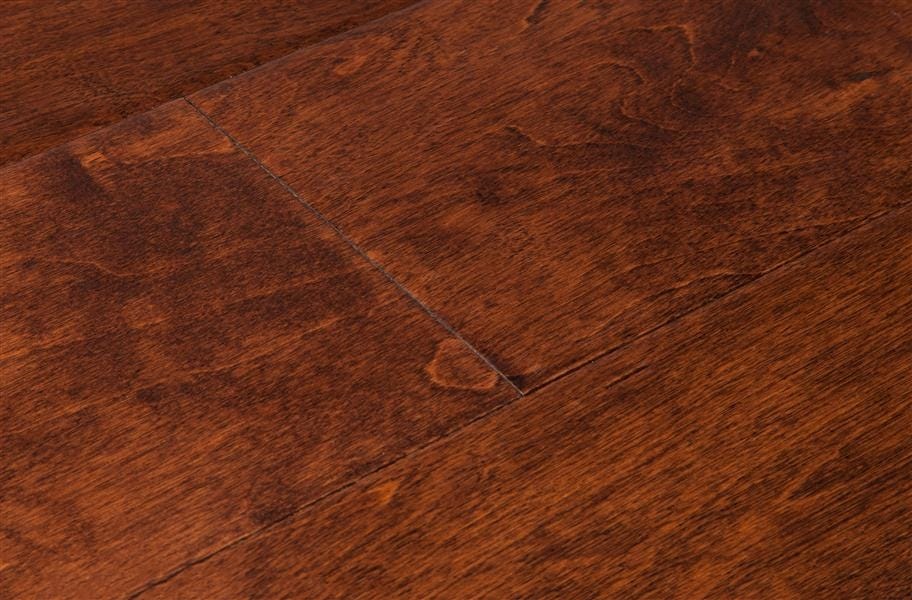
Just like real hardwood floors, engineered wood floors offer a broad selection of looks that can match any home. Discover how different species, textures, and finishes can give you a personalized, unique style.
Species and Colors
Whether you want the versatility of oak, the depth of birch, or the unique character of hickory, there’s a type of wood suited to you. The color of the floor is determined by the stain, as well as the species of wood.
Here are a few different wood species options for you to consider:
- Hickory: Hickory planks are some of the hardest wood floors on the market with a Janka hardness rating* of 1820. They feature high variation between light blonde and deeper tan, depending on the stain.
- Oak: Because there are so many oak subspecies, this wood flooring has the broadest visual range of all wood species. Oak can be stained dark or come naturally light while still showing the unique grain of the wood. This species has a Janka hardness rating of 1350.
- Acacia: Acacia wood has a deep reddish-brown color and bold, attractive wood grain patterns. This species has a Janka hardness rating of 1700.
- Birch: This is a very pale wood that ranges from white, to yellow, and even reddish. This species has a Janka hardness rating of 1210.
- Maple: Maple wood typically has very warm colors, often reddish-brown. This species has a Janka hardness rating of 1450.
*Janka Hardness Rating
Each species of wood has a different Janka hardness rating which is determined by a Janka hardness test. This test measures the force required to embed a steel ball into a sample piece of wood. It then rates wood to determine if the sample is suitable for flooring. The more force it takes to embed the steel ball, the more durable the wood’s surface is against impact and pressure.
Since engineered wood flooring is topped with real wood, the Janka rating scale is used to determine the durability of the floor. The standard rating for all wood flooring options is a rating of 1000 pounds of force or higher.
Finishes
The authentic look of rustic textures is really popular right now, and engineered hardwood delivers on that front. Take your pick of unique textures to enhance your space:
- Handscraped: This texture showcases long scrapes ingrained in the plank. Hand-scraping varies a lot between planks, giving the floor a rustic feel.
- Wirebrushed: The wirebrushed texture creates a more uniform and semi-matte finish that is reminiscent of an antiqued and cared-for floor.
- Textured: Textured flooring adds a touch of personality to any space, giving you a unique look that will remain stylish for years to come.
- Distressed: Distressed flooring is meant to look aged and antiqued like it’s been through a lot. You’ll find burns, knots, wormholes, and scrapes in distressed planks.
- Smooth: Not into all those wood flooring textures? No problem! You can choose a smooth surface for a more polished look.
Don’t worry about those intentional scratches getting messed up by the trials of everyday life. With a thick veneer layer and scratch-resistant finish, the texture of the wood will remain intact.
Installing Engineered Hardwood

There are four main ways to install engineered wood, depending on how the flooring is designed. For any method, you need to make sure your new flooring acclimates to its new environment for at least 24 hours.
Engineered hardwood floors offer more dimensional stability than solid wood floors, meaning they don’t expand and contract as much with temperature changes. However, it’s still a best practice to let the planks get used to the temperature and humidity of the room.
Tongue and Groove
The tongue and groove design is the most common installation method for engineered hardwood. Insert the tongue of one plank into the groove of another to attach the planks. Planks can be nailed down, glued down, or even installed as a floating floor.
If you want to float tongue and groove planks, you will need to glue the planks together using tongue and groove glue.
Interlocking
This installation method isn’t as common as the others, but it’s the most popular among DIYers. The locking mechanism built into each plank allows you to simply attach one plank to another, and lock them together.
You don’t need to hire a professional for this installation, so you can save yourself some money. Interlocking floating floors don’t have to be secured to the subfloor, so they “float” above it.
Glue Down
Glue-down installation is a permanent solution, and it’s well-suited for high-traffic commercial areas where you want to make sure your flooring is stable. This method is best left to the pros.
Nail Down
This is the most common installation method for genuine wood flooring, but it also works with engineered wood. If you’re comfortable using power tools, the nail-down method of installation is a great option. However, we would recommend hiring a professional to make your life easier.
| Related Content >> How to Install Engineered Hardwood |
Installation Accessories
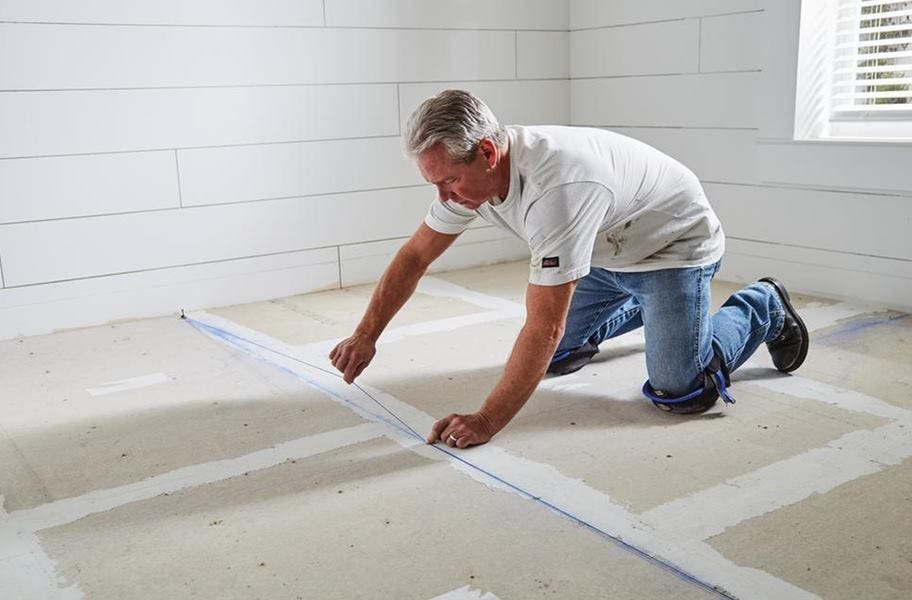
No matter how wonderful engineered hardwood may be, it can’t be completely perfect without some accessories like underlayments, moldings, and moisture barriers. And who doesn’t love accessories?
Moisture Barriers
Installing a moisture barrier over the subfloor is a must for any engineered wood floor. This barrier is crucial in protecting your floor, and you should never install engineered hardwood without a moisture barrier. Plus, you can get an underlayment with a moisture barrier attached.
Underlayment
Underlayments provide a layer of comfortable padding under the floor. Typically made of cork or foam, this layer can cover up some smaller imperfections in the subfloor. Your underlayment will also reduce heat transfer, so the floor won’t get too chilly in the colder months.
Some engineered hardwood comes with an underlayment already attached. That can make life a little easier when it’s time to install.
Moldings and Trim
Moldings add polish to the areas where your floor transitions to another room or meets another type of flooring. Depending on the height and type of floors that are meeting, different styles of molding may be necessary.
Which is Better: Solid Hardwood or Engineered Hardwood?
Engineered hardwood looks just like solid hardwood, but it’s more affordable and more durable. The core provides stability and the benefit of moisture resistance. Best of all, this flooring can be installed as an interlocking floating floor, meaning you can do it yourself!
If you can’t tell, engineered hardwood is kind of a big deal. Real hardwood planks are alright, but they just don’t come with all the bonuses.
| Related Content >> Engineered Hardwood FAQ |
Engineered Hardwood FAQ
To make sure you have all the facts about engineered hardwood flooring, check out some of the most commonly asked questions.
How is Engineered Wood Made?
How engineered wood is made depends on the type of core. Planks with an HDF core consist of the real wood veneer, a single, solid layer of HDF, and a backing layer all glued together. Engineered wood’s other core options use a different process by attaching fiberboard plies on top of each other in opposite directions under the real wood veneer.
Engineered hardwood is topped with real wood veneers that are cut and created using one of three methods, each creating different characteristics in the look of the floor.
- Dry solid-sawn: This allows the wood to dry out slowly at a low humidity level. While this method is more expensive, it allows the veneer to look and feel more solid.
- Rotary-peel: After boiling the log for a certain amount of time at a certain temperature, the log is then scraped along its side to create the veneer, then the veneer is pressed flat.
- Sliced-peel: This involves boiling the log for a certain amount of time at a certain temperature to prepare the wood. Then the wood is sliced from the end and pressed to create a veneer (source).
This slice of real wood is then attached to the core, creating an engineered hardwood plank.
Does the Janka Scale Matter for Engineered Hardwood?
The Janka scale is determined by the force it takes to halfway lodge a .444” steel ball into a wood species. Ideally, the more force it takes, the higher the Janka rating, and the harder the wood species. The results are measured as pounds of force (LBF) required to embed the metal ball. This test is most commonly carried out by the American Society for Testing and Materials (ASTM), and the test itself is known as ASTM D1037.
Most people consider a Janka rating between 1,200 and 1,300 to be average. With a rating of 1,290, red oak provides a decent benchmark for comparing other wood species.
Even though engineered hardwood comes with just a veneer of real wood, the Janka scale can still be useful to you. By knowing the species of the wood veneer, you can determine the Janka rating for engineered flooring. If durability is a big deal for you, then you can choose an option with a higher Janka hardness.
Can I Install Engineered Hardwood Myself?
While all methods of installation can be done by a non-professional, the easiest way to install engineered hardwood is the floating floor method. This is the process of locking the planks together over the subfloor using its tongue and groove design. While this does not require the use of power tools this method might require tongue and groove adhesive to secure the planks if they don’t lock together. Other installation methods include nail-down, staple-down, and glue-down.
Choosing a method of installation depends on your comfort with flooring adhesives and power tools. Just be sure to contact your flooring manufacturer for complete installation instructions.
Does Engineered Hardwood Require Underlayment?
Underlayment is necessary when installing below ground level. For instance, in basements or on ground floors that are the first floor, an underlayment with an attached moisture barrier is required. For any floor above the basement or first-floor underlayment is not necessary but is highly recommended as it helps reduce noise and keep floors warm.
How Do You Clean Engineered Hardwood Floors?
Simple, very common cleaning practices help keep engineered wood floors clean. To ensure a long-lasting, gorgeous floor, practice this cleaning routine regularly.
- Sweep often: Dirt, if not removed, gets ground into your floors and can cause damage over time. Therefore, regularly sweeping your floor helps the floor last. While using a vacuum, set it to the bare floor setting, as a beater bar can scratch or dent your floor.
- Use a damp mop: When mopping engineered wood, it’s best to use a damp –but not wet – mop with a hardwood-approved cleaner. Wet mops allow moisture to sit on your floors and seep through the planks, causing subfloor damage or warping. Mopping your engineered hardwood floor does not have to be intense. It just needs to be done regularly.
Pro tip: Avoid using steam mops on your engineered hardwood floors. Steam mopping uses hot water, which causes engineered wood planks to warp and allows moisture to seep through the floor, compromising the subfloor and the construction of the planks. Unless you want to replace your flooring every few years, steam cleaning is not a proper cleaning method for engineered wood floors.
| Related Content >> How to Clean Engineered Hardwood |
How Often Should Engineered Hardwood be Cleaned?
How frequently you clean your engineered wood floors depends on the amount of foot traffic your floors see. For instance, in low-foot traffic areas of the home, basic cleaning happens twice weekly. For busier homes with pets, kids, or just a lot of people, daily sweeping and light mopping is key to keeping your floors in shape.
Can You Lay Engineered Hardwood Over Hardwood?
You can install engineered wood floors over laminate, vinyl, and solid hardwood floors, among other surfaces. However, other installation options such as glue-down or nail-down are not recommended when installing over existing floors.
Can You Refinish Engineered Wood Floors?
It’s understood that engineered wood should not be refinished unless specified by the flooring manufacturer.
If your engineered floors can be refinished, they only need to be refinished after years of wear. However, It’s also pertinent that the floors have at least a 3mm wear layer. If the wear layer is less than 3mm, for instance, the real wood veneer could be too thin and cause damage to your engineered wood planks.
Remember, it’s always best to check with the flooring manufacturer to better understand the correct process for refinishing their floors.
How Much Does it Cost to Install Engineered Hardwood?
Typically, the cost to install engineered hardwood floors averages between $3 to $8 per square foot for professional installation. However, to save money on your project, some engineered wood floors are made to lock together using tongue and groove planks which can be installed by you much faster than hiring a professional (source).
| Related Content >> Best Engineered Hardwood |
Conclusion
Engineered hardwood flooring is innovative and will increase your home’s value with ease, the only question is, what are you waiting for?
ORDER FREE SAMPLES SHOP ALL ENGINEERED HARDWOOD



